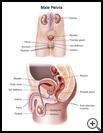
Spermatocele
________________________________________________________________________
KEY POINTS
- A spermatocele is a small fluid-filled sac in the scrotal sac near the testicle. The testicles and scrotum are part of the male reproductive organs.
- Often your child will not need treatment for a spermatocele. If it is painful or large, treatment may include medicine or surgery.
- Follow the full course of treatment prescribed by your child’s healthcare provider. Ask your child’s provider what symptoms or problems you should watch for and what to do if your child has them.
________________________________________________________________________
What is a spermatocele?
A spermatocele is a small fluid-filled sac (cyst) in the scrotal sac near the testicle. The cyst may have whitish fluid that contains sperm. The testicles are in a sac of loose skin, called the scrotum or scrotal sac, which is below and behind the penis. The testicles and scrotum are part of the male reproductive organs.
A spermatocele is also called a spermatic cyst.
What is the cause?
The cause of a spermatocele is not always known. It may be caused by a blockage in the tube (epididymis) that stores and carries sperm from the testicles to the penis. It can also happen after an injury to the testicles.
What are the symptoms?
A spermatocele may be found in adolescent boys during a routine exam. Your child may feel swelling or heaviness in his scrotum, though it is usually not painful.
How is it diagnosed?
Your child’s healthcare provider will examine your child at regular office visits. His healthcare provider will ask about his symptoms and medical history and examine him. Tests may include an ultrasound, which uses sound waves to show pictures of and blood flow to the testicles.
How is it treated?
Often your child will not need treatment for a spermatocele. If it is painful or large, treatment may include:
- Medicine to reduce pain or swelling
- Spermatocelectomy, which is surgery to remove the cyst
Talk to your child’s healthcare provider about which treatment is best for your child.
How can I take care of my child?
Follow the full course of treatment prescribed by your child’s healthcare provider. Ask your child’s provider:
- How and when you will get your child’s test results
- How long it will take your child to recover
- If there are activities your child should avoid and when your child can return to his normal activities
- How to take care of your child at home
- What symptoms or problems you should watch for and what to do if your child has them
Make sure you know when your child should come back for a checkup.
Last modified: 2017-09-15
Last reviewed: 2017-09-14

